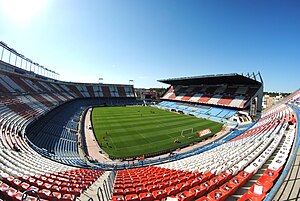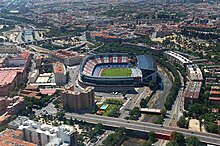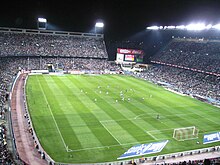Estadio Vicente Calderón
| Estadio Vicente Calderón | |
|---|---|

|
|
| Interior panorama from August 2011 | |
| Earlier names | |
|
Estadio Manzanares (1966–1971) |
|
| Data | |
| place | Paseo de la Virgen del Puerto 67 28005 Madrid , Spain |
| Coordinates | 40 ° 24 '6.2 " N , 3 ° 43' 14.3" W |
| classification | 4th |
| owner | Atlético Madrid |
| start of building | 1961 |
| opening | 2nd October 1966 |
| First game | October 2, 1966 Atlético Madrid 1-1 Valencia CF |
| Renovations | 1971-1972, 1981-1982 |
| demolition | February 2019 to July 2020 |
| surface | Natural grass |
| costs | 450 million pts (1981-1982) |
| architect | Javier Barroso Miguel Ángel García Lomas |
| capacity | 54,907 seats |
| playing area | 105 m × 70 m |
| Societies) | |
|
|
| Events | |
The Estadio Vicente Calderón ( German Vicente Calderón Stadium ) was a football stadium in the Spanish capital Madrid , located directly on the Manzanares River. The club's own stadium was the home of the Atlético Madrid football club until the summer of 2017 and held 54,907 spectators. It was with great facilities of the UEFA in the category 4 (to 2010 Elite Stadium classified). For the 2017/18 season Atlético moved to the converted Wanda Metropolitano with 67,703 seats. The old home of the capital city dwellers was demolished from February 2019 to July 2020.
The construction of the stadium did not consist of a round grandstand, as is usually the case for stadiums of this capacity, but of a free-standing, covered main grandstand and an open semicircular grandstand opposite. What was unusual was that Madrid's city motorway, which runs along the banks of the river, runs directly under the main stand. The seating in the stands was held in the club colors red, white and blue.
history
After the purchase of land for the stadium on March 16, 1961, construction began that same year. The arena celebrated its inauguration on October 2, 1966 and was named “Estadio del Manzanares” after the river Manzanares, on whose banks the stadium stands. At that time the stadium had a total capacity of 62,000 spectators. The first game in the stadium was against Valencia CF. The game ended in a 1-1 draw after goals from Luis Aragonés and Paquito.
In the 1970s, the stadium was rebuilt on behalf of President Vicente Calderón . On February 6, 1972 in the game against Athletic Bilbao , which ended in a 1: 2 defeat, the newly built main stand was inaugurated. The main stand is completely covered (5,000 m²) and is made of iron and aluminum. For the official inauguration of the entire converted stadium, an international match between Spain and Uruguay was held on May 23, 1972 , which the hosts won 2-0. The venue was renamed from “Estadio del Manzanares” to “Estadio Vicente Calderón” in honor of the patron and club president Vicente Calderón .
On 30 July 2007 Atlético signed a contract with the city administration, the demolition of the stadium and an expansion of the Manzanares - shore park provides. In the summer of 2017, the football club moved to the Wanda Metropolitano in the east of the city, which was renovated as part of the application for the 2016 Summer Olympics and expanded to a capacity of 73,000 spectators.
The last European Cup match took place on May 10, 2017 in the now dilapidated Estadio Vicente Calderón. In the 2016/17 UEFA Champions League semi-final second leg , Atlético faced city rivals Real Madrid . Atlético won the game 2-1, but with a 3-0 win in the first leg, Real moved into the final . On May 21, 2017, the last matchday of LaLiga 2016/17, Atlético won their last game against Athletic Bilbao in the old stadium. Ángel Correa scored 3-1 in the 89th minute and is Atlético's last goalscorer in the old stadium. The final football match was the Spanish Cup final between FC Barcelona and Deportivo Alavés on May 27, 2017. Paco Alcácer scored the last goal in Vicente Calderón in stoppage time in the first half to make it 3-1.
1000 apartments are to be built on the building site of the stadium . The demolition work began in February 2019. When the opposite grandstand and the back-end grandstands are removed, a detour road will be built over the former playing field in order to demolish the main grandstand as the last grandstand element. At the end of July of that year, the association sold two pieces of land on the stadium grounds on which two residential buildings with 340 units are to be built. In September, the main rank should also be eliminated.
On July 2, 2020, the last part of the stadium was demolished.
Games of the 1982 World Cup in the Estadio Vicente Calderón
The stadium hosted the 1982 World Cup and was home to the three Group D games in the second final round.
-
28 June 1982, the second final round, group D: Austria - France 0: 1 (0: 0)


-
July 1, 1982, the second final round, group D: Austria - Northern Ireland 2: 2 (0: 1)


-
4 July 1982, 2nd final round, Group D: Northern Ireland 1-4 France (0-1)


Stadium areas
Panorama picture
Spectator area
The playing field is separated from the spectator seats by a seven meter wide, cemented run-off zone. The spectators can enter the stadium via one of the 57 entrances. The “code system” used makes it possible to determine for all areas of the stadium how many people are there at any given time. In this way, any problems can be identified at an early stage and countermeasures can be initiated. In an emergency, all visitors can be evacuated from the stadium within six minutes.
Of the total of 54,851 seats, only the 18,850 seats in the main stand are covered. A room with an integrated cafe ( Sala VIP ) is also integrated into this stadium complex, so that guests can watch the game on screen away from the hustle and bustle. In addition, there are 74 private boxes ( Palcos Privados ) for the affluent public , which can be rented and are equipped with service, security, catering , fax , air conditioning , television , cloakroom and a toilet.
Players area
For the teams there is a changing area with showers and a changing room, which measures 820 square meters for both the home and visiting teams. In addition, a medical department and a relaxation area with a massage room are available to the players. There is also a doping control room in the players' area.
Media facilities
There are 35 independent and soundproof commentary booths, which can be found in the main stand. There are also various rooms in the stadium complex for holding press conferences or assemblies, as well as an interview zone.
Visitor service
Fan shop
Atlético's official fan shop, Megastore 1903 , is also known as Tienda Rojiblanca . Here you can find all the official fan articles that the club sells.
Club museum
The museum with the official name Museo Atlético de Madrid & Colección Pablo Ornaque is one of the largest museums of its kind in Spain with an exhibition area of over 600 square meters. The exhibition covers the history of the Atlético Madrid football club from its founding in 1903 to the present day. This includes a presentation of all previous jerseys of the "Rojiblancos" as well as the club's trophy collection. In addition, the development of the sport of soccer is illustrated using contemporary utensils such as soccer balls or soccer shoes. In addition, a tour of the stadium is offered as part of the museum visit, which includes a tour of the field, the VIP area and the team cabins.
childcare
In the stadium, there is a club's own play paradise of over 400 square meters for children between the ages of four and twelve. The so-called IndiPark includes a. a swimming pool made of balls, slides and the IndiGol, where the little ones can prove their football skills. On days when the stadium a soccer match of Atletico Madrid is taking place, which offers IndiPark a nursery service to. This enables parents to leave their children in the care of trained specialists for the time they meet. Furthermore, (children's) birthdays can be celebrated in the IndiPark .
restaurant
The club's own restaurant, the 1903 Sport Arena, offers space for up to 800 people and is set up in the style of a sports bar. In addition to four large screens, there are also six other modern plasma televisions . Club members of Atlético Madrid and holders of season tickets only need to pay a reduced price for their restaurant visits.
other services
There are two public doctor's offices in the stadium whose services can be used during the games. Another special feature in the stadium is a wellness area with a fitness studio , tanning studio and hairdressing salon.
Stadium technology
The floodlight system consists of 220 floodlight projectors with an intensity of 2000 lux . There are two large display boards in the open corners of the stadium (LG Vision Type, Rainbow Color. Size 8 m × 5.12 m = 41 m²). The loudspeaker system consists of eight amplifiers and 70 loudspeakers, which are distributed throughout the stadium and cover all areas equally.
Stadium environment
Around the stadium there are a variety of services of all kinds, a bank branch , a car repair shop with a car wash (Laminauto), some travel agencies, pubs and restaurants, event rooms for parties and business premises for receiving guests including catering and offices. Around the stadium there are 37 bars, for example that of the German Atlético Madrid fan club, the Peña Atlética Centuria Germana, the "La Esquina del Calderón".
See also
Web links
- Stadium data, atleticomadrid.de
- Stadium on the club's website , clubatleticodemadrid.com (Spanish, English)
- Estadio Vicente Calderón , stadiumdb.com (English)
- Visitor report from 2004 , groundhopping.de
- Detailed picture gallery , euro.stades.ch (French)
Individual evidence
- ↑ According to the Atlético Madrid website, the new stadium will be ready in summer 2017 (as of April 14, 2016): http://en.clubatleticodemadrid.com/atm/features
- ↑ munimadrid.es: Public park on the grounds of the Vicente Calderón (Spanish)
- ↑ weltfussball.de: Match report Atlético Madrid against Real Madrid
- ↑ tagesspiegel.de: The last procession to the Vicente Calderon Article from May 10, 2017
- ↑ Demolition of the Vicente Calderón in full swing. In: stadionwelt.de. July 25, 2019, accessed July 29, 2019 .
- ↑ Madrid: Final piece of Vicente Calderón falls. In: stadiumdb.com. July 3, 2020, accessed on July 4, 2020 .


